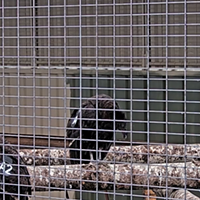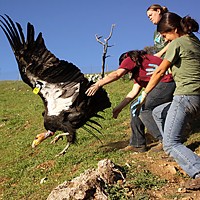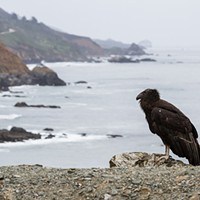While walking recently on an Arcata Marsh and Wildlife Sanctuary trail past the power-line tower near Allen Marsh and South G Street, I spotted a large turkey vulture (Cathartes aura) perched on the top of the tower with its wings outstretched to dry in the morning sunlight. Looking through my telephoto lens, I noticed a large white patch with the number 80 on the top of the turkey vulture's left wing — the first time I'd ever seen that.
Eliminating the possibility that local turkey vultures had formed sports teams and were now wearing jersey numbers, I contacted local wildlife experts and bird watchers for ideas about why this turkey vulture was tagged with a number. Eventually, I got in touch with Chris West, program manager of the Yurok Tribe Northern California Condor Restoration Program, which is a collaboration between the Yurok Tribe and Redwood National and State Parks.
The goal of the restoration program, which the Yurok Tribe began back in 2008, is to reintroduce the culturally and ecologically important condor to the wild locally. The bird has been absent from the Northern California/Southern Oregon region for more than 100 years.
"This is definitely our marked vulture No. 80," said West in an email reply. Trapped and tagged on July 13, 2011, in Korbel, it was an average-sized adult in good condition, but for a little lead. "No. 80 did have high enough blood lead at the time that we considered them to have been exposed to a point source of lead. Based on other research done on vultures, it most likely came from lead ammunition fragments found in scavenged carcasses." West said the turkey vulture's years of close proximity to the ocean could mean fishing gear is a possible culprit but "their mercury load was low, indicating that they don't often forage on marine resources."
The reason West was trapping and tagging local turkey vultures (sometimes called the "janitors of the outdoors") was to see how much lead exposure condors would be face if they were to be released in our area. The initial studies looked at lead levels in turkey vultures during hunting season and found they were lower here than other places where condors have been re-established.
California condors in the wild were rapidly declining in numbers by the mid-1980s due to lead contamination and the effects of DDT, which led to thinning of eggshells. So biologists captured the last 22 remaining condors in the wild for captive breeding. In April of 1987, they caught the last critically endangered wild condor.
In one of the most successful captive breeding programs ever, there are now over 500 condors in the wild or waiting to be released. According to Tiana Williams-Claussen of the Yurok Tribe Wildlife Department, plans are underway to release the first condors back into the wild locally in the spring of 2022.
A recent Yurok Tribe Facebook post announced that construction has begun on the Northern California Condor Restoration Program's Condor Release and Management Facility to keep the condors safe as they acclimatize to a new environment.
And back to turkey vulture No. 80: "Over the years, No. 80 has been our most sighted individual," said West. "Your sighting is the 27th reported to us. When we began this project, many people told us that there were resident vultures, although no one could tell us whether they were truly resident and that winter birds were not just simply different individuals than the summertime birds just at the southern end of migration from farther north. No. 80 has shown that they are a true resident, observed throughout the year. The only month we lack observation data for is April, so keep a lookout next spring!"
Indeed, I can't wait to keep a lookout in 2022 to see a wild condor soaring in our local skies — maybe even perched on a power-line tower at the Arcata Marsh.
Mark Larson (he/him) is a retired Humboldt State University journalism professor and active freelance photographer who likes to walk.




Comments
Showing 1-1 of 1